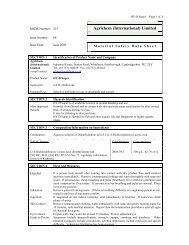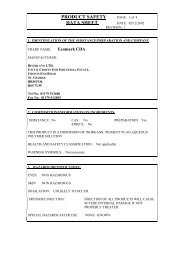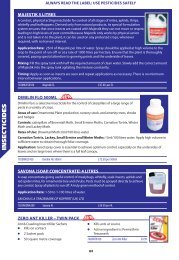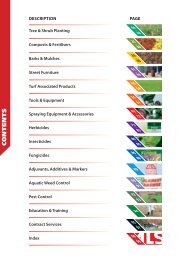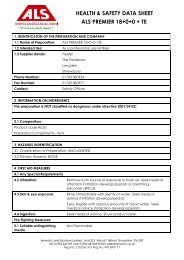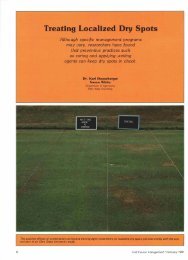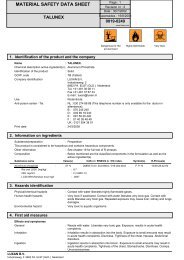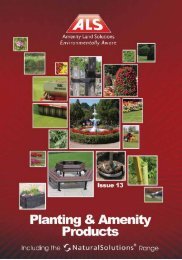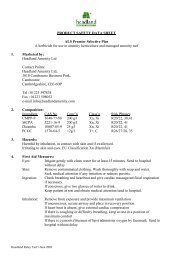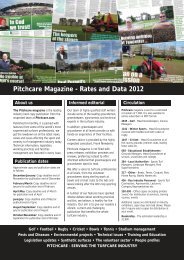Earning his Spurs - Pitchcare
Earning his Spurs - Pitchcare
Earning his Spurs - Pitchcare
You also want an ePaper? Increase the reach of your titles
YUMPU automatically turns print PDFs into web optimized ePapers that Google loves.
The products are as effective as the<br />
traditional chemical products they<br />
replace, but have none of the associated<br />
health, safety or environmental problems.<br />
The company formulates and<br />
manufactures all its own products with<br />
health, safety and the environment in<br />
mind. Where possible, they incorporate<br />
their own unique seaweed extracts. They<br />
have over one hundred years combined<br />
experience in formulation chemistry and<br />
problem solving in industries as diverse as<br />
engineering and manufacturing, food and<br />
beverage processing, janitorial cleaning,<br />
waste water and sewage treatment,<br />
pollution control, agriculture and<br />
horticulture.<br />
Seaweed has been recognised and used<br />
in the agricultural, horticultural, amenity<br />
and garden markets for many years as a<br />
growth stimulant, or combined with<br />
nutrients to form a comprehensive range<br />
of fertilisers and soil conditioners.<br />
However, research conducted by a pan<br />
European body found it was an excellent<br />
surfactant, coupled to being produced<br />
from a highly sustainable resource.<br />
The products are derived from brown<br />
seaweeds such as Laminaria digitata and<br />
Ascophyllum nodosum, which are fast<br />
growing cold water kelps found in<br />
abundance around the coast of Northern<br />
Europe and Iceland. Research illustrates<br />
an estimated 100 million tonnes of kelp<br />
seaweed are available worldwide for a<br />
sustainable annual harvest, with a<br />
renewable life cycle of between three and<br />
five years.<br />
Sea-Chem produces a number of<br />
seaweed extracts from various brown cold<br />
water seaweeds. The seaweed is<br />
sustainably harvested from the West Coast<br />
of Ireland; it is washed, dried and ground<br />
before being shipped to their contractor’s<br />
factory in England for processing. The<br />
extracts are produced using a proprietary<br />
natural process that does not include the<br />
use of high temperature, high pressure or<br />
additional chemicals such as caustic<br />
potash and solvents, and have developed<br />
a comprehensive range of products, based<br />
on several unique technologies, which<br />
replace hazardous materials used in the<br />
following diverse areas:<br />
• Agriculture, horticulture and amenity<br />
• Industrial cleaning and process<br />
degreasing<br />
• Janitorial and consumer cleaning<br />
products<br />
• Oil spill clean-up and land remediation<br />
• Waste water and effluent treatment<br />
Seaweeds and kelp have been used for<br />
thousands of years by mankind to assist<br />
with the growing of food, as a direct food<br />
source and in housing and industry.<br />
Utilising modern technology, access to<br />
seaweed has improved together with a<br />
greater understanding of the ecology of<br />
the seas. The whole basis of the seaweed<br />
industry is no different to that of<br />
sustainably managing land-based crops -<br />
understand the capacity of the resource<br />
base and utilise it to the best long-term<br />
advantage by ensuring its use is targeted<br />
to the most appropriate application, as<br />
determined by its particular qualities.<br />
In conjunction with taking energy from<br />
the sun in the form of photosynthesis,<br />
kelps and seaweeds have always relied on,<br />
and will continue to rely upon, nutrient<br />
run-off from the landmass for their<br />
growth and provision of unique qualities.<br />
It is the ongoing return to the land of t<strong>his</strong><br />
complex plant nutrient, in the form of<br />
seaweeds, that makes for investigation<br />
into the future sustainability of marine<br />
derived materials, and the benefits t<strong>his</strong><br />
recycled resource can provide to man and<br />
the global ecology.<br />
As the demands on agricultural land<br />
increase, and production expectations<br />
become higher, so too is the importance<br />
of sensible utilisation of all possible<br />
nutrient inputs into the human food<br />
chain.<br />
Nearly four fifths of the world’s surface<br />
is covered with oceans and seas. Over<br />
millions of years, various nutrients of the<br />
land have been washed into the seas of<br />
the world making them increasingly<br />
mineral rich. For eons, since before the<br />
first recording of <strong>his</strong>tory, man has sought<br />
nutrition from the seas - either directly or<br />
as a means of enhancing the soils in which<br />
crops are grown or to grow the crop itself.<br />
The predominant use of health giving<br />
Knotted Wrack (Ascophyllum nodosum) Oarweed (Lamininaria digitata)<br />
kelp, seaweeds and fish were - and in<br />
some cases still are - based on cultures<br />
such as Japan, whereas many other parts<br />
of the world have gone through phases of<br />
utilising t<strong>his</strong> remarkable resource.<br />
Seaweed’s usage was dependent on the<br />
availability of conventional food crops at<br />
various times, together with the quality<br />
and production expectations of crops<br />
grown with the assistance of seaweeds and<br />
fish. On the islands of Orkney, seaweed<br />
had long been gathered by Orcadians,<br />
dragged up from the beaches and spread<br />
across the fields as a fertiliser. T<strong>his</strong><br />
tradition was capitalised on by the island<br />
lairds who quickly saw that there were<br />
profits to be made gathering the seaweed<br />
and burning it to produce kelp. The ash<br />
produced was rich in potash and soda,<br />
substances that were eagerly sought after<br />
by the glass and soap industries.<br />
Various initiatives around the world are<br />
being taken in response to the<br />
environmental pressures, either already<br />
applying to seaweed habitat or that which<br />
can be anticipated to occur as a result of<br />
population growth on coastal zones. As<br />
more is learned about the oceans’<br />
resources and the complex relationships<br />
contained in marine ecology around the<br />
world, local and broader programmes,<br />
including research, are increasing to<br />
conserve and understand what is<br />
considered a very valuable asset to the<br />
world.<br />
In future articles, we shall consider the<br />
diverse ways in which seaweed is now<br />
used, how it is sustainably harvested and<br />
processed, and look in depth at the<br />
advantages that it can bring to<br />
horticulture, agriculture and, in particular,<br />
amenity land applications.<br />
For further information email:<br />
steve.nicholls@sea-chem.co.uk or visit<br />
www.sea-chem.co.uk<br />
109



